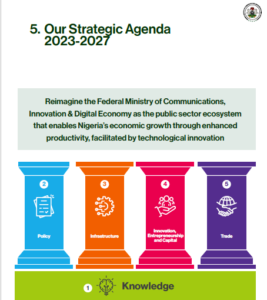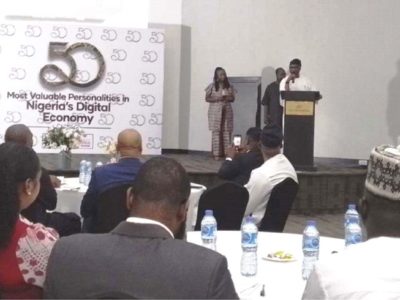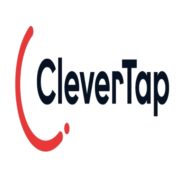I. Executive Summary
The laudable efforts of the Ministry of Communication, Innovation and Digital Economy’s (MoCIDE) [and the Minister and his team] in developing a Strategic Plan [SP] deserve accolades. Therefore, this policy brief only provides an illustrative analysis and recommendation to indicate to the Ministry of Communication, Innovation and Digital Economy’s (MoCIDE) that it requires a Policy Roadmap [PR] for the implementation of its 31-page strategy document, otherwise it becomes like a business plan rather than an effective policy plan for stakeholder mapping and implementation at a policy level.
RELATED: Tijani unveils 5 pillars blueprint, plans to push up startups fundraising to $5b by 2027
The Strategic Plan is anchored on five solid pillars: Knowledge, Policy, Infrastructure, Innovation, Entrepreneurship and Capital, and Trade. Each pillar addresses critical aspects of Nigeria’s digital economy, with specific goals and objectives. While the strategic plan is commendable, this brief offers policy recommendations, assigns agency responsibilities, and lessons from successful international models to enhance effectiveness in each of the Pillars.
As commendable as it is, especially in contrast to other Ministries in Nigeria, there is a pressing need to further articulate MoCIDE’s Strategic Plan [SP] into a Policy Roadmap [PR] in collaboration with policy consultants and key Directors who will oversee its implementation across various government agencies and within the Ministry. This articulation will aim to delineate the specific roles of different government agencies in the attainment of this strategic plan, with a particular focus on policy indicators. For instance, a PR should clearly outline the responsibilities of entities such as NIPOST, NITDA, NCC, NIGCOMSAT, within the goals in the document. Additionally, it should elucidate the roles of the private sector and development partners, while also exploring mechanisms for incentivizing their active participation in bringing the Plan to life.
Beyond the confines of the Ministry, it is imperative for the Ministry to clearly identify and have a strategy for engaging other relevant agencies, including Ministries. Facilitating collaboration with these entities is paramount in ensuring the successful execution of the Strategic Plan. This collaborative approach should extend to agencies beyond those mentioned in the Strategic Plan, such as the National Office for Technology Acquisition and Promotion [NOTAP], which operates under the purview of the Ministry of Innovation, Science, and Technology, the National Identity Management Commission [NIMC] which has recently moved to the Ministry of Interior [a policy dialectic for another day], National Frequency Management Council (NFMC) within the Ministry, Council for Digital Innovation and Entrepreneurship within the Presidency with secretariat domiciled in NITDA; and the office of the National Security Adviser [NSA].
II. Analysis
In view of the above points, here are some initial thoughts to show quick example of how the above approach could be further extended for practical policy implementation:


i. Pillar 1: Knowledge – Diversifying Nigeria’s Economy through Knowledge and Technological Innovation
Goal: Develop Nigeria as a Technical Talent Hub, Enhance Global Research Position, Achieve 95% Digital Literacy by 2030
Proposed Leading Agency under the Ministry: National Information Technology Development Agency (NITDA)
Approach: NITDA needs to collaborate with educational institutions and the private sector to incentivize and reward training of technical talents and promote tech skills and entrepreneurship, but not directly involved in the implementation; NITDA could draw inspiration for successful models for policymakers from South Korea and Finland for approaches to building tech education programs and innovation ecosystems.
ii. Pillar 2: Policy – Driving Innovation, Entrepreneurship, and Inclusive Growth through Strong Policy Direction
Goal: Nine Key Policy Initiatives
Proposed Leading Agency/Ministry: Pillar 2 can be achieved by the leadership of the Ministry of Communication, Innovation and Digital Economy [MoCIDE], working with each Agency relevant in the context of the Policy [for example AI and Blockchain currently under NITDA’s purview], and collaborating with Relevant Ministries and Agencies, such as the Ministry of Youths, Ministry of Education, and the Ministry for Industry, Trade and Investment.
Approach: MoCIDE should lead policy initiatives, with close collaboration from relevant Ministries and Agencies. For example, consider working with the Ministry for Industry, Trade and Investment to reshape the Intellectual Property [IP] framework and structure in Nigeria into a single IP office instead of the current situation, where Copyright Commission is distinct from the Commercial Department of the Ministry of Trade in charge of trademark and patents. It can study best practices from the United States and China for fostering innovation and protecting intellectual property.
iii. Pillar 3: Infrastructure – Constructing Robust Digital Infrastructure for a Prosperous Digital Economy
Goal: Laying 95,000 Kilometers of Fiber Optic Cable, Digital Public Infrastructure, and Revitalizing NIPOST
Proposed Leading Agency:
A. For Digital Infrastructure: Primarily, but not limited to National Information Technology Development Agency (NITDA); Nigerian Communications Commission (NCC); NIGCOMSAT.
B. NIPOST Revitalization: Nigerian Postal Service (NIPOST) through a Public-Private Partnership (PPP) model.
Approach: Seek minimal entry involvement of private sector consortium in silo spaces [Institutions of learning; Open Hub Parks] and incentivize investment in digital infrastructure. Learn from Switzerland and Singapore for policy approaches in rural broadband deployment and digital inclusion. NIGCOMSAT may need to work with experts [space; finance; and legal] to identify areas where it loses revenue due to the exploitation of Nigeria’s space, as well unlock revenue for Nigeria through legal innovation, which can be invested into boosting Nigeria’s digital infrastructure.
iv. Pillar 4: Innovation, Entrepreneurship, and Capital Access – Fostering a Conducive Environment for Innovation and Entrepreneurship
Goal: Expand the Innovation Ecosystem, Increase Patient Capital Availability, Sector-Specific Support
Proposed Leading Agency/Ministry:
A. Expanding the Innovation Ecosystem: NITDA leads this effort and is accountable.
B. Increasing Patient Capital: MoCIDE collaborating with Nigerian Stock Exchange; Bank of Industry [BOI]; CBN; Investors Groups; to identify entry points for innovation without major disruption to the financial system as well as developing frameworks that protect and attract investments.
Sector-Specific Support requires Collaboration with relevant ministries and private sector stakeholders, as well as learning from successful models in Israel, Switzerland, and South Korea for fostering startup ecosystems and innovation.
Pillar 5: Trade – Enhancing Global Technology Trade Participation and Economic Complexity Index (ECI) Ranking
Goal: Advance Nigeria’s Rank in ECI Technology Index, Grow Intra-African Trade by 500%
Proposed Leading Agency under the Ministry:
A. Improving ECI Ranking: NITDA.
B. Growing Intra-African Trade: Nigerian Communications Commission (NCC) and Nigerian Postal Service (NIPOST) collaboration.
Successful trade facilitation models for policymaking can be found in Singapore and Mauritius.
General Recommendations:
Develop Detailed Implementation Plans: Collaborate with policy consultants and key directors across agencies to create detailed policy documents outlining the roles, responsibilities, and specific indicators for success.
Engage External Agencies: Extend collaboration beyond the Ministry to agencies like the Office of the National Security Adviser, National Office for Technology Acquisition and Promotion (NOTAP), and the National Frequency Management Council (NFMC).
Evaluate Overburdened Agencies: Assess whether certain agencies, like NITDA, are overburdened with multiple responsibilities (e.g., Start Act, Blockchain, AI) and consider the creation of new agencies, as done with the National Data Protection Commission (NDPC).
Address Cryptocurrency Ban: Recognize the challenges posed by the current cryptocurrency ban in Nigeria and consider its implications on the digital economy working with Associations such as SIBAN [Stakeholders in Blockchain Technology Association of Nigeria]. For example, a Blockchain Innovation Policy in Nigeria cannot succeed without the lifting on the ban on Crytocurrency, and that requires the MoCIDE working with the Central Bank of Nigeria to develop a framework that encourages innovation while also protecting the financial system instead of an outright ban.
Learn from Successful Models: Continuously look for and learn from successful international models as it relates to each of the pillars in the MoCIDE Strategic Plan.
Conclusion:
The strategic plan outlined by the Ministry of Communication, Innovation and Digital Economy presents a significant opportunity for Nigeria to advance its digital economy. However, for this vision to be realized, it is crucial to translate broad goals into specific, actionable policies and programs. Collaboration among government agencies, the private sector, and partners will be essential in achieving the outlined objectives and fostering a thriving digital economy in Nigeria.
Timi Olagunju is a foremost Tech lawyer and Policy consultant with more than a decade experience in technology policy and regulations. He can be reached on LinkedIn or twitter
DOWNLOAD POLICY PAPER AS PDF DOCUMENT































